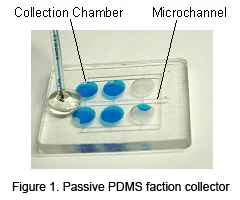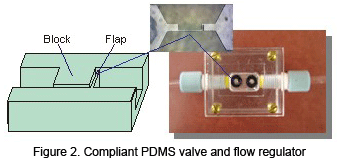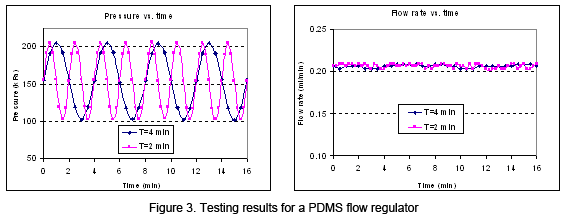| Welcome | People | Research | Presentations | Publications | Facilities | Links |
|---|
|
|
|
|
|
> Stimuli-Responsive Polymers |
Microfluidic Devices with PDMS as a Functional Material

![]() Poly(dimethylsiloxane) (PDMS) is an elastomeric polymer widely used in MEMS and microfluidics. We are exploring PDMS as an inexpensive and flexible functional material in innovative microfluidic devices.
For example, PDMS surfaces are hydrophobic with contact angles of 105~110. We have developed a passive, PDMS-based microfluidic fraction collector,
which exploits this hydrophobicity and operates by the principle that surface tension induces a pressure barrier that must be overcome for a liquid front to advance in a hydrophobic channel.
The device consists of a number of collection chambers that are connected by fractionating microchannels, which have varying cross-sectional dimensions to provide distinct pressure barriers against the advancing liquid front.
The liquid is fractionated and fills the chambers in a sequence determined by design of these pressure barriers. Experiments have shown that an aqueous solution was successfully fractionated to fill
six 240-ul chambers over a 24-hour time period at a flow rate of 1 ul/min (Figure 1). The pressure barriers were low (< ~1.3 kPa), and cross-contamination between solutions in adjacent chambers was negligible.
Thus, the device can be widely useful in applications such as microdialysis and chromatography.
Poly(dimethylsiloxane) (PDMS) is an elastomeric polymer widely used in MEMS and microfluidics. We are exploring PDMS as an inexpensive and flexible functional material in innovative microfluidic devices.
For example, PDMS surfaces are hydrophobic with contact angles of 105~110. We have developed a passive, PDMS-based microfluidic fraction collector,
which exploits this hydrophobicity and operates by the principle that surface tension induces a pressure barrier that must be overcome for a liquid front to advance in a hydrophobic channel.
The device consists of a number of collection chambers that are connected by fractionating microchannels, which have varying cross-sectional dimensions to provide distinct pressure barriers against the advancing liquid front.
The liquid is fractionated and fills the chambers in a sequence determined by design of these pressure barriers. Experiments have shown that an aqueous solution was successfully fractionated to fill
six 240-ul chambers over a 24-hour time period at a flow rate of 1 ul/min (Figure 1). The pressure barriers were low (< ~1.3 kPa), and cross-contamination between solutions in adjacent chambers was negligible.
Thus, the device can be widely useful in applications such as microdialysis and chromatography.

![]()
As an elastomer, PDMS is highly compliant (with a nominal Young¡¯s modulus of 750 kPa, compared with 170 GPa for silicon). We have been purposely exploiting the compliance of PDMS to create microfluidic control devices.
Structurally simple and relatively straightforward to fabricate, these devices represent innovative approaches to passive flow control, and offer interesting challenges in design and theoretical analysis.
For example, we have developed microvalves and flow regulators that exploit the PDMS compliance. In the simplest configuration, these PDMS devices consist of a microchannel
in which a flexible flap and a rigid block are arranged in series to form a flow constriction (Figure 2).
For valving applications, the device is designed such that the hydrodynamic force deflects the flap away from the block to allow passage of the forward flow, and towards the block to maximally seal the constriction and mimimize the reverse flow.
For flow regulation, the device is designed to function as a passively adaptive orifice. The fluid enters from the flap side of the channel, such that the flap is deflected toward the block, with which it effectively forms an orifice.
The effect of an increase in the pressure across the device is to increase the flow rate and decrease the orifice size. The decrease in orifice size, on the other hand, has the opposing effect of reducing the flow rate.
The flap-block system is designed such that these two effects cancel out to maintain a constant flow rate in the face of pressure variations. Testing results have shown that the micro flow regulator
is capable of maintaining a constant flow rate with less than 1% fluctuations under pressures ranging from 100 to 200 kPa (Figure 3).

Researchers
Bozhi Yang , Ph.D. Student (ME)
Jared Metter, Undergraduate Student (ME)